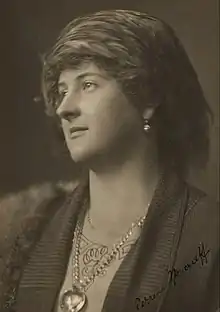Pérrine Moncrieff | |
|---|---|
 Moncrieff in 1937 | |
| Born | Pérrine Millais 8 February 1893 London, England |
| Died | 16 December 1979 (aged 86) Wakapuaka, New Zealand |
| Occupations |
|
| Spouse |
Malcolm Moncrieff
(m. 1914; died 1968) |
| Children | 2 |
| Relatives | John Everett Millais (grandfather) |
| Awards | Loder Cup (1953) |
Pérrine Moncrieff CBE (née Millais; 8 February 1893 – 16 December 1979) was a New Zealand writer, conservationist and amateur ornithologist.
Biography
She was born in London, England in 1893 as Pérrine Millais.[1] She was the granddaughter of the painter Sir John Millais, one of the founders of the Pre-Raphaelite Brotherhood. She spent her early life living in London, Brussels and in Perthshire in Scotland.[2] She married Captain Malcolm Moncrieff, a veteran of the Boer War, in 1914. They moved from Britain to New Zealand after the end of the First World War where they settled at Nelson, having originally planned to move to Canada.[2] She was the first female President of the Royal Australasian Ornithologists Union (RAOU), 1932–1933. She first joined the organisation in 1923 and two years later published New Zealand birds and how to identify them. The book was a success, with six editions published from 1925 through to 1961.[2]
She is credited with being almost single-handedly responsible for setting aside land that would eventually be the Abel Tasman National Park.[3] Moncrieff was awarded the Loder Cup in 1953. In the 1975 Queen's Birthday Honours, she was appointed a Commander of the Order of the British Empire, for services to conservation as a naturalist and to the Abel Tasman National Park.[4] The government of the Netherlands awarded her the Order of Orange-Nassau in 1974, in recognition of her efforts to protect Abel Tasman National Park, an area of significant importance in the history of Dutch exploration.[2]
In 2017, Moncrieff was selected as one of the Royal Society Te Apārangi's "150 women in 150 words", celebrating the contributions of women to knowledge in New Zealand.[5]
Publications
Books she authored include:
- Moncrieff, P. (1925). New Zealand Birds and How to Identify Them. Whitcombe & Tombs: Auckland. (Field-guide. 5 editions published to 1961) Colour plates by Lily A. Daff.
- Moncrieff, P. (1965). People Came Later. Author: Nelson.
- Moncrieff, P. (1976). The Rise and Fall of David Riccio. Ambassador: Wellington.
References
- ↑ Hodge, Robin. "Pérrine Moncrieff". Dictionary of New Zealand Biography. Ministry for Culture and Heritage. Retrieved 2 January 2015.
- 1 2 3 4 Secker, HL (1980). "Obituary. Perrine Millais Moncrieff". Emu. 80 (3): 171. doi:10.1071/mu9800171.
- ↑ Young, David (2004). Our Islands, Our Selves. Dunedin: University of Otago Press. ISBN 1-877276-94-4.
- ↑ "No. 46595". The London Gazette (3rd supplement). 14 June 1975. p. 7406.
- ↑ "Pérrine Moncrieff". Royal Society Te Apārangi. Retrieved 11 May 2021.
Further reading
- Robin, Libby. (2001). The Flight of the Emu: a hundred years of Australian ornithology 1901–2001. Carlton, Vic. Melbourne University Press. ISBN 0-522-84987-3